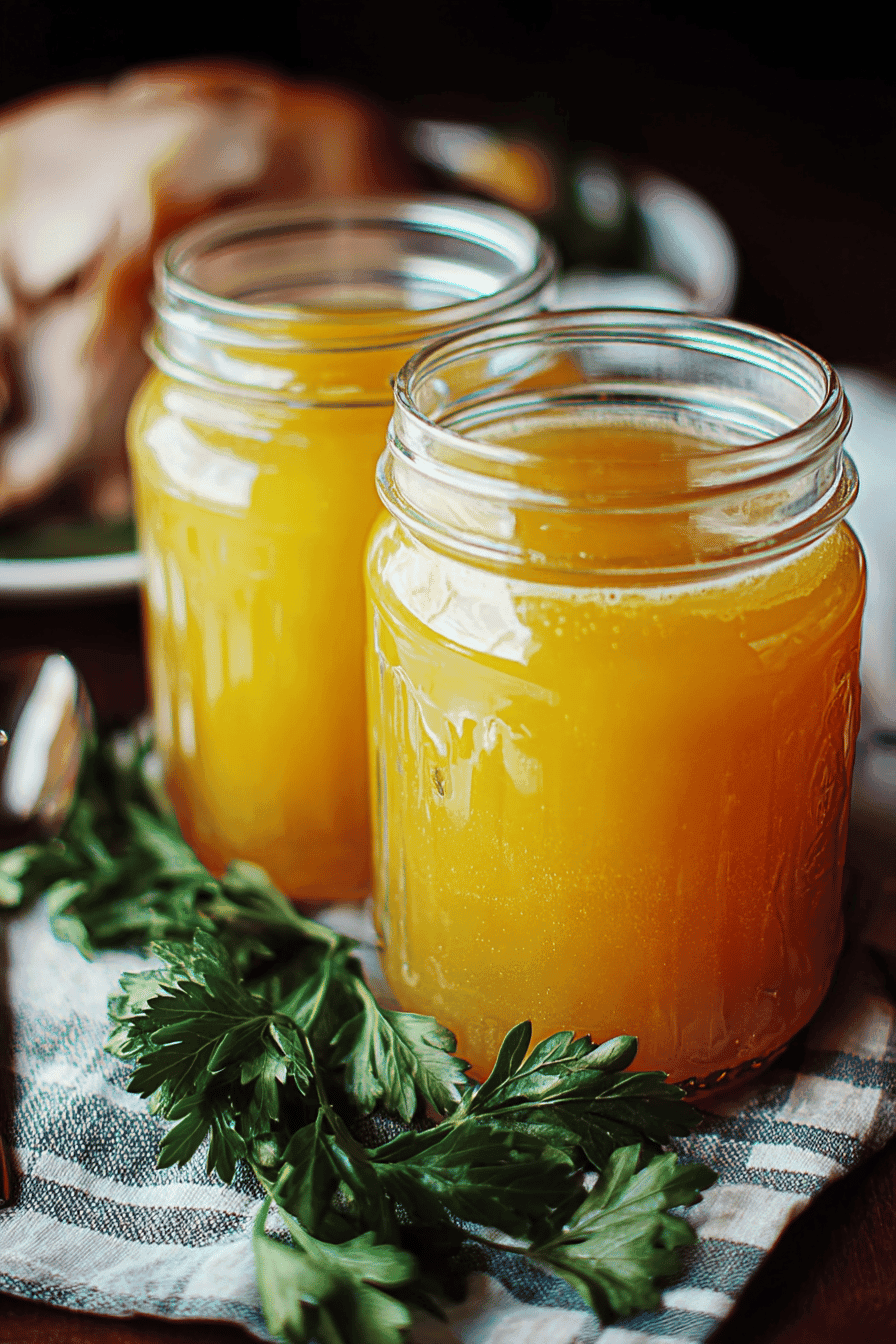Benefits and Advantages of Turkey Stock
This turkey stock recipe is particularly effective due to its simplicity and the array of health benefits it offers. The ease of preparation makes it accessible even for beginner cooks, requiring minimal ingredients and straightforward steps. The stock harnesses the natural richness of turkey, providing a flavorful base that enhances any dish without the need for artificial additives. Healthwise, turkey stock is a nourishing option, rich in protein and minerals, supporting immune health and hydration. Its light fat content and homemade nature ensure it is a wholesome choice compared to store-bought versions. This recipe also stands out as it can be easily customized to suit various dietary preferences, making it a versatile staple in the kitchen. By focusing on fresh, quality ingredients, this preparation method ensures a deep, savory flavor that complements soups, sauces, and stews.
Jump to:
- Benefits and Advantages of Turkey Stock
- Essential Ingredients for Turkey Stock
- Dietary Substitutions to Customize Your Turkey Stock
- How to Prepare the Perfect Turkey Stock: Step-by-Step Guide
- Mastering Turkey Stock: Advanced Tips and Variations
- How to Store Turkey Stock: Best Practices
- Nutritional Value of Turkey Stock
- FAQs: Frequently Asked Questions About Turkey Stock
- What ingredients do I need to make homemade turkey stock?
- How do I make turkey stock from leftover turkey bones?
- How long does homemade turkey stock last in the fridge and freezer?
- Can I use turkey stock the same way I use chicken or vegetable stock?
- Should I roast vegetables before adding them to turkey stock, and does it improve flavor?
- Homemade Turkey Stock Recipe for Rich Thanksgiving Flavor
- Ingredients
- Instructions
- Last Step:
- Notes
- Nutrition
- Did you make this recipe?
Essential Ingredients for Turkey Stock
- 1 cooked turkey carcass (about 4 pounds), meat mostly removed
- 4 to 5 pounds turkey or chicken wings (optional for deeper flavor; can be roasted)
- 2 large yellow onions (about 1 pound), peeled and quartered
- 4 medium stalks celery, coarsely chopped
- 4 large carrots, coarsely chopped
- 2 heads garlic, halved crosswise (optional)
- 1 teaspoon whole black peppercorns (optional)
- Few sprigs fresh herbs such as parsley, thyme, sage, oregano, marjoram, or bay leaf (optional)
- 2 tablespoons olive oil (for roasting wings and browning vegetables)
- About 1 gallon (14 to 16 cups) water to cover
- Kosher salt and freshly ground black pepper (to taste, usually added after cooking)
Each ingredient contributes depth, nutrition, and flavor: turkey bones provide collagen and protein; fresh vegetables add vitamins and sweetness; and herbs and spices enhance aroma and complexity.

Dietary Substitutions to Customize Your Turkey Stock
To accommodate various dietary needs and ingredient availability, several substitutions can be made when preparing turkey stock. For vegan or vegetarian diets, replace turkey bones with mushrooms, kombu seaweed, and hearty root vegetables to replicate umami flavor. Those with gluten intolerance should avoid any gluten-containing additives, though this basic turkey stock recipe remains naturally gluten-free. For a low-sodium option, reduce or omit added salt and rely on fresh herbs and peppercorns to enhance flavor. Cooking methods can also be adapted: slow simmering traditionally extracts maximum flavor over 3-4 hours, but pressure cooking can reduce the time to 1-2 hours without sacrificing quality. These flexible adjustments ensure the stock fits a wide range of preferences and health requirements.
How to Prepare the Perfect Turkey Stock: Step-by-Step Guide
- Gather all ingredients: turkey bones, carrots, celery, onions, garlic, bay leaves, peppercorns, herbs (if using), olive oil, and filtered water. Prepare vegan alternatives if desired.
- Rinse turkey bones and vegetables: Clean thoroughly to remove impurities for a rich, clear stock.
- Prepare the stock pot: Place bones and vegetables in a large stockpot and cover with about 1 gallon (14-16 cups) cold water to fully submerge ingredients.
- Bring to a gentle boil: Heat over medium until boiling, then reduce heat to low to maintain a gentle simmer. For speed, use a pressure cooker with adjusted timing.
- Skim foam: Within the first 30 minutes, remove foam and impurities from the surface to keep the broth clear and flavor clean.
- Add aromatics: Introduce bay leaves, peppercorns, and fresh herbs to infuse flavor during simmering.
- Simmer for 3 to 3.5 hours: Allow the stock to reduce and develop depth, or 1-2 hours if using a pressure cooker.
- Season cautiously: Add salt and additional herbs towards the end for better flavor control, especially for low-sodium diets.
- Strain the stock: Use a fine-mesh sieve or cheesecloth to remove solids for a clear broth.
- Cool quickly: Place the pot in an ice water bath to reduce temperature safely and prevent bacterial growth.
- Store properly: Divide into airtight containers. Refrigerate for up to one week or freeze for up to three months depending on usage plans.
“Slow, gentle simmering is key for extracting rich flavors and gelatin from turkey bones, yielding a deeply satisfying stock.”
Following these precise steps will produce a flavorful, nutrient-packed turkey stock ideal for enhancing gravies, soups, and sauces throughout the year.

Mastering Turkey Stock: Advanced Tips and Variations
To master turkey stock, begin by roasting the turkey bones and wings to develop deep caramelized flavors that enrich the stock’s complexity and color. Incorporate fresh herbs like thyme, rosemary, or parsley during the final hour of simmering to add delicate aromatic layers without overpowering the natural turkey essence. Regularly skim foam and impurities during simmering to maintain clarity and prevent cloudiness in your stock.
For variations, consider adding exotic spices such as star anise or cloves to bring subtle warmth and depth. Utilize leftover turkey carcasses after holiday meals to reduce waste, making flavorful stock that honors sustainability. For vegan versions, integrate umami-rich items like nutritional yeast or soy sauce alternatives to simulate a savory profile. Adjust simmering times or liquid ratios depending on whether you want a lighter broth for soups or a richer base for gravies and stews. These tips transform basic turkey stock into a versatile culinary foundation suitable for many dishes.
“Roasting bones and browning vegetables deeply enhance turkey stock’s richness, making it a foundational ingredient in hearty recipes.”
How to Store Turkey Stock: Best Practices
Proper storage preserves turkey stock’s flavor and ensures food safety. After cooking, cool the stock quickly by placing the pot in an ice water bath, but do not leave it out longer than two hours to avoid bacterial growth. Transfer the cooled stock to airtight containers, minimizing air exposure to maintain freshness.
In the refrigerator, store turkey stock for up to four days. For longer storage, freeze the stock in freezer-safe containers or heavy-duty plastic bags, leaving about an inch of headspace to accommodate expansion. Label containers with the date for easy tracking. When reheating, thaw refrigerated stock overnight or gently warm frozen stock on the stovetop or microwave, bringing it to a simmer before use. Avoid repeated heating and cooling cycles to maximize quality and safety.
Nutritional Value of Turkey Stock
| Nutrient | Amount per Serving (1 cup) | Benefits |
|---|---|---|
| Calories | 4 | Very low-calorie base for soups and sauces |
| Fat | 0.1 g | Minimal fat content makes it heart-healthy |
| Protein | 0.4 g | Contains collagen and amino acids from bones |
| Carbohydrates | 0.3 g | Minimal carbs, suitable for low-carb diets |
| Sodium | 3.0 mg | Low sodium when seasoned post-cooking, helpful for heart health |
Turkey stock provides hydration with essential minerals like calcium and magnesium, supporting bone and metabolic health. It contains natural proteins and micronutrients without added preservatives or artificial flavors, making it a wholesome choice for diverse diets. Learn more about Health Benefits of Turkey Stock.

FAQs: Frequently Asked Questions About Turkey Stock
What ingredients do I need to make homemade turkey stock?
How do I make turkey stock from leftover turkey bones?
How long does homemade turkey stock last in the fridge and freezer?
Can I use turkey stock the same way I use chicken or vegetable stock?
Should I roast vegetables before adding them to turkey stock, and does it improve flavor?

Homemade Turkey Stock Recipe for Rich Thanksgiving Flavor
🦃 Enhance your holiday dishes with this rich and flavorful turkey stock that serves as an ideal base for soups, gravies, and stews.
🍲 Perfect for using up leftover turkey carcass, this stock adds depth and hearty taste to any dish.
- Total Time: 4-4.5 hours
- Yield: Approximately 2 quarts (8 cups) 1x
Ingredients
1 cooked turkey carcass (about 4 pounds), meat mostly removed
4 to 5 pounds turkey or chicken wings (optional for deeper flavor; can be roasted)
2 large yellow onions (about 1 pound), peeled and quartered
4 medium stalks celery, coarsely chopped
4 large carrots, coarsely chopped
2 heads garlic, halved crosswise (optional)
1 teaspoon whole black peppercorns (optional)
Few sprigs fresh herbs such as parsley, thyme, sage, oregano, marjoram, or bay leaf (optional)
2 tablespoons olive oil (for roasting wings and browning vegetables)
About 1 gallon (14 to 16 cups) water to cover
Kosher salt and freshly ground black pepper (to taste, usually added after cooking)
Instructions
1. Optionally, preheat oven to 450°F (230°C). Place turkey or chicken wings on a baking sheet, drizzle with olive oil, and season with salt and pepper. Roast for 40 to 50 minutes, flipping to brown evenly. Reserve pan drippings.
2. In a large stockpot, add broken pieces of the turkey carcass, roasted wings, onions, celery, carrots, garlic, peppercorns, and herbs.
3. Optionally, brown vegetables in the stockpot over medium heat with olive oil until golden.
4. Add water to the pot, enough to cover all ingredients. Add pan drippings. Simmer uncovered for 3 to 3.5 hours, reducing by half.
5. Remove solids, strain the stock through a fine sieve into a bowl. Strain again for clarity if desired.
6. Cool completely before storing in jars, refrigerate for up to one week or freeze for up to three months.
Last Step:
Please leave a rating and comment letting us know how you liked this recipe! This helps our business to thrive and continue providing free, high-quality recipes for you.Notes
🦴 Save turkey neck, carcass, and bones to maximize flavor.
🔥 Roasting wings deeply enhances color and richness.
🥕 Browning vegetables beforehand adds caramelized depth.
- Prep Time: 10-15 minutes
- Roasting: 40-50 minutes
- Cook Time: 3-3.5 hours
- Category: Stock
- Method: Simmering
- Cuisine: American
- Diet: Gluten-Free
Nutrition
- Serving Size: 1 cup
- Calories: 4
- Sugar: 0.1g
- Sodium: 3.0mg
- Fat: 0.1g
- Saturated Fat: 0.0g
- Unsaturated Fat: 0.1g
- Trans Fat: 0g
- Carbohydrates: 0.3g
- Fiber: 0.1g
- Protein: 0.4g
- Cholesterol: 0mg







